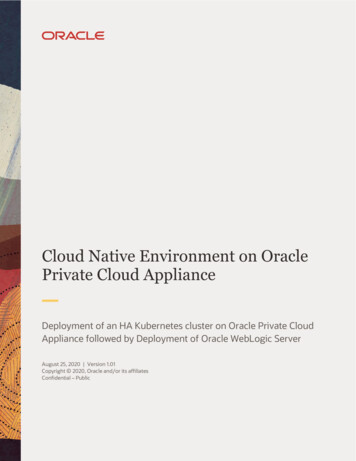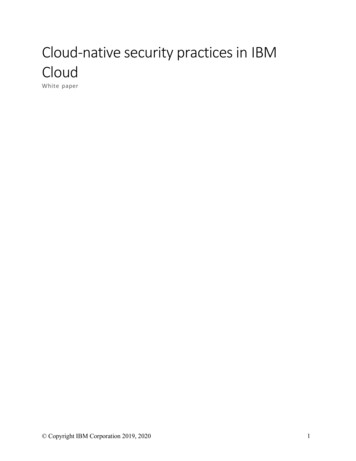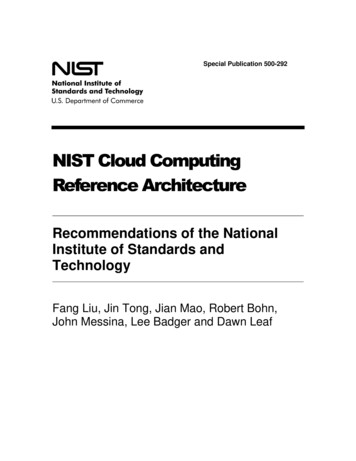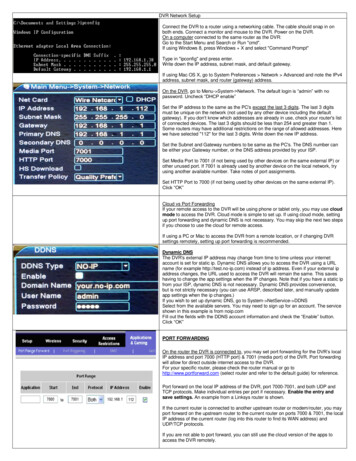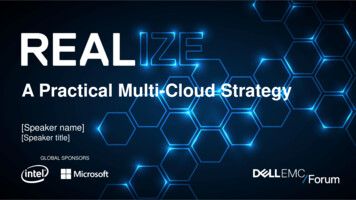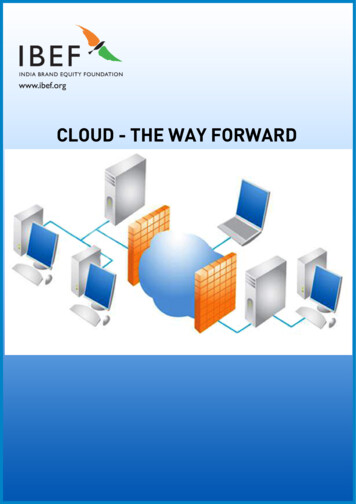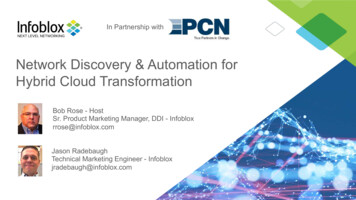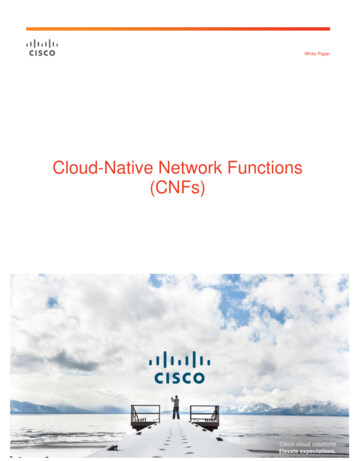
Transcription
White PaperCloud-Native Network Functions(CNFs) 2018 Cisco and/or its affiliates. All rights reserved. This document is Cisco Public Information.Page 1 of 15
ContentsIntroduction . 3Primary cloud-native constructs . 4Benefits of being cloud native . 6Distributed microservices . 6Lightweight footprint . 6Service discovery . 6Lifecycle management . 6State separation . 6Availability and resiliency . 7Operational benefits . 7Scalability . 7Components technology stack . 7Automation and common functions . 8Control and user- and data-plane microservices. 9Cloud-native services . 9Containersss fast networking . 9Hybrid world implications and MANO integration . 12Cisco CNF implementation examples . 13Cloud-native broadband router CNF . 13Mobile CNF . 14Summary . 15More information . 15 2018 Cisco and/or its affiliates. All rights reserved. This document is Cisco Public Information.Page 2 of 15
IntroductionCloud-native principles and technology have proven to be an effective acceleration technology in building andcontinuously operating the largest clouds in the world. This new technology has been selected by Cisco and othersin the industry to develop next-generation Virtual Network Functions (VNFs) called Cloud-Native NetworkFunctions (CNFs). These CNFs, when running inside telecommunications premises, form a private cloud, and thesame public cloud principles can be effectively used. CNFs cover all branches of the service provider market,including cable, mobile, video, security, and network infrastructure.Virtualization and VNFs helped us in getting started in moving toward cloud-native applications. Virtualization,when done properly, offered software models with increased flexibility with hardware dependencies eliminated.However, there are limitations in that VNFs upgrades are slow, restarts take a long time, CLI is still the maininterface, software was typically a lift and shift operation, hypervisors such as OpenStack were hard to install, therewas little elasticity, and scaling was problematic.Cloud-native applications address these limitations. Cloud-native applications in general have thesecharacteristics: Developed using microservices architecture (that is, 12-factor apps) Managed by Kubernetes-style orchestration Built-in microservice discovery mechanisms Supports dynamic elasticity and scale Resilient services Improved feature velocity Smaller footprint with fast restart Continuous deployment and automation principles Consistent lifecycle management across containers Modern health and status telemetryCloud Native customer benefits are depicted in the figure below. 2018 Cisco and/or its affiliates. All rights reserved. This document is Cisco Public Information.Page 3 of 15
Web scale Speed: Lego approach to app creation shortens time to market and lets customer control pace ofinnovation. Flexibility: Strong infrastructure offers allow one to focus on app layers, where they createvalue/differentiation versus recreating common infrastructure. Efficiency: Reusable services across teams and business units translate into lower OpEx cost fordeveloper and customer. Improved business outcomes: Speed, scale, and agility lead to increased revenue. Deployment Standard DevOps principles and tooling are used to allow for increased feature velocity as well asconsistent deployments. Security Cloud-native tooling for security scans and cloud penetration tests provide increased confidence in thesecurity of solutions. Smaller CNFs can independently control subscribers (limit the blast zone) versus the monolithicbox approach. Monitoring Standard tools such as Kubernetes, Prometheus, and Elastic Search provide common health and statusof containers.The cloud-native approach has been proven at web-scale companies and has shown increased speed, flexibility,efficiency, and business outcomes as depicted. Teams can now focus more on the business value in theapplication versus the infrastructure.Primary cloud-native constructsBeing cloud native is an approach to building and running applications that fully exploit the advantages of the cloudmodel. A cloud-native application utilizes a collection of tools that manage and simplify the orchestration of theservices that make up the application. These services, each with its own lifecycle, are connected by APIs and aredeployed as containers. These containers are orchestrated by a container scheduler, which manages where andwhen a container should be provisioned into an application and is responsible for lifecycle management. Cloudnative applications are designed to be portable to different deployment environments: for example, in a public,private, or hybrid cloud. Continuous delivery and DevOps are methods used to automate the process of building,validating, and deploying services into a production network.Cloud Native constructs are depicted in the figure below. 2018 Cisco and/or its affiliates. All rights reserved. This document is Cisco Public Information.Page 4 of 15
Microservices: An architectural style that structures an application as a collection of loosely coupledservices to implement business capabilities. Microservices are commonly deployed in containers andenable the continuous delivery and deployment of large, complex applications. Each microservice can bedeployed, upgraded, scaled, and restarted independently of other services in the application as part of anautomated system, enabling frequent updates to live applications without affecting end customers. Containers: Containers are another form of virtualization, using Operating System (OS)–level virtualization.A single OS instance is dynamically divided among one or more isolated containers, each with a uniquewritable file system and resource quota. Containers can be deployed on both bare metal and virtualmachines. Containers deployed on bare metal offer performance benefits to virtual machines by eliminatingthe hypervisor overhead. Although each microservice is commonly deployed in a separate container,multiple microservices may be deployed per container to address application and performancerequirements, for example, when colocation of services logically simplifies the design or when services forkmultiple processes in a container. Continuous delivery: Makes an individual application change ready for release as soon as it is ready,without waiting for bundling with other changes into a release or an event such as a maintenance window.Continuous delivery makes releases easy and reliable, so organizations can deliver frequently, at less risk,and with immediate feedback from end users. The way service providers consume software this frequentlywill revolutionize speed to market. Eventually, deployment becomes an integral part of the business processand enterprise competitiveness, taking advantage of canary and A/B testing in the real world rather thanartificial labs. DevOps: DevOps is the utilization of lean and agile techniques to combine development and operationsinto a single IT value stream. DevOps enables organizations to build, test, and release software morerapidly and iteratively by applying continuous integration and delivery. For example, DevOps enables theautomation of deploying and validating a new software feature in an isolated production environment, whichcan then be rolled out more broadly into production after it has been proven. To fully realize DevOps,service providers must adopt cloud-native techniques, establish automated continuous integration, anddeliver pipelines with its vendors. (See Figure 3.)Service providers are looking to reduce OpEx by automating and simplifying their network operations, allowing forfaster services time to market, and deploying across a broad range of cloud environments. Cloud-nativetechnologies provide the fundamental building blocks to build applications that achieve these objectives. 2018 Cisco and/or its affiliates. All rights reserved. This document is Cisco Public Information.Page 5 of 15
Benefits of being cloud nativeA cloud-native architecture has many benefits. The following sections capture the primary benefits and bestpractices for applying cloud-native principles to CNFs to further define Cisco’s progress and strategy.Distributed microservicesExpanding on previous discussion, microservices are componentized, reusable software modules enabling anumber of benefits for the customer and the development organization. Microservices expose smaller discretefunctions to an application through APIs. APIs are maintained and versioned and promote reuse of microservicesin other applications. For example, microservices for control plane are used across a number of differentapplications. Microservice APIs are typically exposed over a RESTful interface or via a message bus, which allowseach service to choose the best technology available for client operations. For example, Java can be used for acontrol-plane service, and Go can be used for data-plane services. This componentization allows open-sourcetechnologies to be more easily integrated into the application or swapped for different technologies as theapplication evolves.Lightweight footprintContainers are a way of virtualizing an application process or set of processes and are inherently lightweightbecause, unlike a virtual machine, the OS is shared across containers. Significant performance improvements canbe realized when starting and upgrading containers during lifecycle operations. Containers may be deployed onbare metal with a basic Linux OS or can be deployed on virtual machines residing on top of a hypervisor. Althoughsome of the benefits of containers are limited when running on virtual machines, a majority of the instances do notrequire the virtual machine to be upgraded for lifecycle events. For example, upgrading the software containers in alifecycle event do not require the virtual machines to be upgraded.Service discoveryService discovery is one of the primary components of the cloud-native stack and is used to provide a real-timeservice registry for all available services. The service registry enables new services to be dynamically orchestratedinto an application. Services are automatically scaled and recovered via Kubernetes if a service becomesunavailable and the service must be restored.Lifecycle managementOne of the primary benefits of moving to containerized microservices is the ability to orchestrate the containers sothat separate lifecycle management processes can be applied to each service. This allows for each service to beversioned and upgraded singularly as opposed to upgrading the entire application or virtual machine image. Whenupgrading an application, the container scheduler determines which individual services have changed and deploysonly those specific services into the broader application. When the application is implemented with the appropriatelevel of state separation, this process allows for fully automated in-service upgrades and rollback of the containersthat make up the application.State separationOne of the most commonly agreed-on design patterns in cloud-native applications is a clean separation of stateful(also known as backing services) and stateless services. Application services containing functional logic (database,file system, or cache) should be separated from stateful services. For example, a service handling a create sessionrequest implements the logic for creating the session but stores the session information in a separate statefulservice, which physically stores the session to memory or disk. This allows for the stateless application services tobe autonomous, lightweight, upgradable, recoverable, and rapidly scalable. 2018 Cisco and/or its affiliates. All rights reserved. This document is Cisco Public Information.Page 6 of 15
Stateful services are more challenging because of where and how the state is actually stored: for example, on thefile system, in memory, or in a cloud storage file system. Stateful services must address the availability,consistency, and portability of state, which typically requires replication across one or more containers whilemaking sure that consistency of the state is maintained.Availability and resiliencyCloud-native applications inherently provide support for high availability and resiliency through service discoveryand load-balancing transactions across stateless application containers. In addition, because containers arelightweight, recovery times are far less than when recovering a virtual machine, physical box, or application as awhole. This allows for faster and more granular ways of responding to failure events.High availability cannot be solved by container orchestration alone, and, in most cases, the application itself hasresiliency requirements. Stateful services, such as a resilient database, require resiliency beyond the inherentfeatures of a cloud-native architecture, which requires state synchronization and data integrity. Additionally,protocol services require specific failover and availability mechanisms defined at the protocol level.Operational benefitsFundamentally, containerized applications running on bare metal perform better than those running on virtualmachines because there is not the overhead of a hypervisor. Because of the lightweight footprint of containers, thespeed of instantiating or recovering services is optimized. Because virtual machine instantiation includes anunderlying OS and disk resources, the provisioning process can take minutes, whereas a container instantiationcan take seconds. When containers are deployed on top of virtual machines—for example, in a CNF architecture—and the hypervisor overhead is still present, there are still a number of operational benefits because containershave a separate lifecycle from virtual machines. For example, a software upgrade or recovery might not require theinstantiation of a new virtual machine. Therefore, because containers are lightweight, the benefits of starting,recovering, and upgrading services are substantially faster.ScalabilityA containerized architecture enables the ability to scale each microservice independently. Each container ismonitored based on KPI metrics, enabling the orchestration scheduler to scale/descale individual containers. Asnew containers are started up for scaling, they register themselves in the service discovery layer and areautomatically orchestrated into the broader application. Load balancing is used to transparently add new containerinstances without affecting the containers that depend on that container.Components technology stackFigure 4 is a model that Cisco CNF applications typically follow. Each major area is summarized further in the restof this section, starting from the top and working down. 2018 Cisco and/or its affiliates. All rights reserved. This document is Cisco Public Information.Page 7 of 15
Automation and common functionsCustomers expect that Cisco CNFs will behave and operate in a consistent manner across applications, causingthe need for: Consistent open framework for cloud-native container management Ability to easily deploy and update cloud-native containers from Cisco Visibility into container deployments throughout the entire customer’s VNF lifecycle Inherent security in deploying Cisco CNF containers in the cloud and on the customer premises Standard methodology for CNF deployment across Cisco One-click deployment options to make it easy for customers Ability to do everything via APITo meet these expectations, Cisco utilizes a common Helm chart format for its container structure. This structurecontains all the deployment information, as well as Kubernetes deployment instructions. By having each containerfollow a consistent chart structure, customers can more easily integrate the containers into their cloud-native CDsystems if desired.For Cisco customers wanting to use Cisco deployment, higher level deployment functionality is provided by adeployment user interface/API. Cisco is using tools such as Spinnaker, which provides a framework to manage adistributed deployment at scale with simple operational tooling. Deployment tools such as Spinnaker and Helmprovide benefits, including: Multicloud location: Applications can reside in multiple locations, including the private data center and inthe cloud with multiple cloud providers. Automated releases: Create deployment pipelines that run integration and systems verifications, spin upand down containers, and monitor rollouts. Pipelines (that is, workflows) can be triggered from events. Ability to build in deployment best practices: Create and deploy immutable images for faster, easierrollbacks and elimination of hard-to-debug configuration drift issues. Built-in deployment strategies such asred/black and canary. Verification via automation: Included to make sure of a successful deployment. 2018 Cisco and/or its affiliates. All rights reserved. This document is Cisco Public Information.Page 8 of 15
Control and user- and data-plane microservicesCisco provides control- and data-plane microservices. These microservices typically communicate via Kafkamessages for control- to data-plane interaction and through specialized interfaces for high-speed data transferwhere latency matters. Microservices from Cisco are used for upstream and downstream data processing as wellas for networking areas such as diameter routing. Configuration is provided via products such as Etcd.Later sections detail more about control and data planes and cable and mobility use cases.Cloud-native servicesThe cloud-native services offered are from a standard Cloud-Native Compute Foundation (CNCF) common stack.We typically classify the services into the following areas: Messaging: Kafka consumers and producers are used. Data store: Teams primarily use Mongo or Cassandra as a backing store. Security: Vault is used for certificate stores with M-TLS for encryption. Logging: Typical ELK stack is used with fluentd. Configuration: etcd. Health and status: Prometheus in conjunction with Grafana is used. Service mesh: Istio. Orchestration: Kubernetes and Docker containers.Containersss fast networkingBasic container networking uses CNI implementations such as Weave, Flannel, Cisco Contiv-VPP, and others.High-speed data-plane interaction between containers and the external network requires multiple networks toimplement the CNF functionality. Cisco differentiates in this area with its own high-speed data-plane applications:FD.io and Vector Packet Processing (VPP), for example. Cisco’s approach takes advantage of the low overhead ofcontainers to deliver higher performance using cloud-native technologies to build the network functions so they runin the same network and user space as the applications. Network functions become part of the service topology.Network functions are truly just another service and can be developed and deployed using the same tools as theapplications with the same velocity. Cisco software uses user space versus the kernel providing benefits such asease and speed of upgrade, less system call overhead, and decreased dependency on Linux networking.Technology usage is FD.io (VPP data plane), DPDK (network), and SPDK (storage).The VPP platform is an extensible framework that provides out-of-the-box production quality switch/routerfunctionality, which can run on commodity CPUs. The primary benefits of VPP are its high performance, proventechnology, modularity and flexibility, and rich feature set. The framework allows anyone to plug in new graphnodes without the need to change core or kernel code. VPP supports a cloud-native architecture with its ability tobe orchestrated as a part of a Docker containerized solution. VPP is proven in many networks today and is thebasis for multiple Cisco virtualized network functions.Additionally, the Cisco data-plane containers use a Go language agent to access VPP. This Go language librarywas open-sourced by Cisco via the Ligato program. Ligato (github.com/ligato) provides a mechanism for deliveringand managing agents for cloud-native network functions to enable them to become part of the application servicetopology, all in user space. 2018 Cisco and/or its affiliates. All rights reserved. This document is Cisco Public Information.Page 9 of 15
For integration of CNI interaction and high-speed data-plane interaction, Cisco has developed Contiv integratedwith VPP to abstract container connectivity and networking. Contiv is a user space–based, high-performance, highdensity networking plug-in for Kubernetes, which then uses FD.io/VPP as the industry’s highest performance dataplane. Functionalities included are the allocation of IP addresses to networking-related pods (IPAM) andprogramming of the underlying infrastructure it uses (Linux TCP/IP stack, OVS, VPP, and so on) to connect pods toother pods in the cluster and/or to the external world. It also implements K8s network policies that define whichpods can talk to each other. (See Figure 5.)InfrastructureCisco cloud-native applications operate on bare metal as well as well as in VM-based environments. Cisco offersthe Cisco UCS bare metal infrastructure as well as cloud management infrastructure provided by the CiscoContainer Platform. Cisco has chosen Kubernetes as its common container orchestration platform. Cisco isproviding a managed Kubernetes service via the Cisco Container Platform to make sure of secure and reliableplatform for CNFs.The Cisco Container Platform is a fully curated, lightweight container management platform for production-gradeenvironments, powered by Kubernetes, and delivered with Cisco support. It reduces the complexity of configuring,deploying, securing, scaling, and managing containers via automation coupled with Cisco’s best practices forsecurity and networking. The Cisco Container Platform (Figure 6) is built with an open architecture using opensource components, so you're not locked in to any single vendor. It works across both on-premises and publiccloud environments.Benefits are: The ability to easily manage multiple clusters Simple installation and maintenance Networking and security consistency Transparent application deployment, both on the premises and in public clouds Persistent storage 2018 Cisco and/or its affiliates. All rights reserved. This document is Cisco Public Information.Page 10 of 15
The Cisco Container Platform will offer support for Kubernetes on bare metal as a service. It will perform the baremetal hardware bringup, including the installation of the operating system, configuration of the system, andsubsequent deployment of Kubernetes. Additional Kubernetes clusters can be brought up on demand. To supportthe hybrid world, OpenStack and VMware will be supported.The Cisco Container Platform is offering various modes to support cloud native directly as well as the transitionfrom VMs to containers (hybrid mode) where VMs and containers coexist.The Cisco Container Platform will support container networking by natively integrating the Contiv-VPP/Ligato workpreviously mentioned into the Kubernetes deployment. In this manner, typical CNI-based container networking canbe supported as well as high-speed networking use cases, all controlled by common policies.Distributed telecommunications cloud requirementsContainer-based CNF systems will need to support a distributed telecommunications cloud from the data center tothe edge. The containers will be mapped to the external network via a Contiv-VPP/Ligato framework, which willsupport external connectivity requirements to areas such as the DC Interconnect (DCI), virtual routers, and virtualswitches. Cisco is actively working the architecture and technical aspects of fast networking for containers and howwe can make the networking architecture a part of the broader network fabric with service provider WAN. Inaddition, interworking with SR-IOV is under discussion as well as container-to-VM-based interworking for CNF/VNFchaining use cases. This architecture is considering failure domain considerations in the multisite deploymentmodels as well as connectivity for MPLS/SR to the TOR, MPLS/SR to the host vSwitch, and MPLS/SR to the CNF.The different areas of the network are important for placement. Figure 7 shows the support of smallerenvironments at the edge through the data center with the need for cloud-native techniques across allenvironments. 2018 Cisco and/or its affiliates. All rights reserved. This document is Cisco Public Information.Page 11 of 15
Hybrid world implications and MANO integrationCloud-first companies will likely use public cloud for new applications when they can but will use private cloudwhen they must because of latency requirements and packet rate needs as well as for data sovereignty,compliance, and other needs. Companies will be in a hybrid cloud mode for some time as they transition. Thecustomer will have applications spread across public clouds accessed through private connections to the onpremises systems. Cisco, with its deep networking background, is the right vendor to help one optimize trafficpatterns, secure interactions, reduce costs, and provide flexibility.In a similar analogy, the hybrid world is driving the need for container-based systems to coexist with VM/bare metalworkloads while using common orchestration. This includes hybrid VM/container systems, which drive VNF/CNFinterworking. Because a majority of service providers are currently deploying NFV cloud solutions based on VNFsrunning on virtual machines, Cisco’s cloud-native strategy can be supported on top of virtual machines in an NFVMANO architecture as previously described and still brings significant advantages because it is using cloud-nativeautomation techniques. When cloud-native techniques such as dynamic discovery and container scheduling areintegrated into the CNF, this integration dependency is simplified. (See Figure 8.) 2018 Cisco and/or its affiliates. All rights reserved. This document is Cisco Public Information.Page 12 of 15
These options will require cloud-native network functions to support a number of deployment pipeline integrationssuch as NFV management and organization (MANO), Open Network Automation Platform (ONAP), central officerearchitected as a data center (CORD), and public and private clouds running on bare metal and virtual machines.Cloud-native applications support an enhanced level of portability to multiple deployment pipelines with continuousintegration and deployment capabilities required to meet these requirements.Cisco CNF implementation examplesCloud-native broadband router CNFThe Cisco cable team is applying cloud-native virtualization to CMTS DOCSIS using cloud-native techniques. Thistransformative work enables more effective management and deployment of cable networks. The effort is calledthe cloud-native broadband router.In contrast to hardware-based systems, the new system will separate control and data plan functionality intomicroservices that can be separated and event
Distributed microservices Expanding on previous discussion, microservices are componentized, reusable software modules enabling a number of benefits for the customer and the development organization. Microservices expose smaller discrete functions to an application through APIs. APIs are maintained and versioned and promote reuse of microservices
